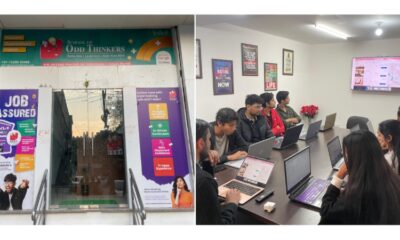Tech
From Strategy to Structure: Create a Strong Content Framework for Your Website

Information consumption habits have evolved. A more visual, fast-paced method of information sharing and short-form videos have made user engagement a commodity. Still, content—especially messaging on websites—stands the test of time and continues to be an essential part of all designs.
Copy messaging is essential in a lot of ways, including educating the user about a brand’s goals and objectives. When creating a website, the design process and overall design language should include a content framework. However, creating copy that tells the story of your brand involves more than just choosing words that go well together; visibility requires a more nuanced approach to this layered process.
With artificial intelligence at the forefront of many content strategies, you can increase user engagement, SEO, and most importantly, the positioning of your brand within your industry, by creating a framework tailored to your brand.
EXPLORING THE OVERALL GOAL
Every effective framework starts with a goal that guides all design and messaging decisions. In digital design, content development ought to be centered around a primary goal. Think about the ultimate goal (or goals) for the website. The goals guiding your content strategy and technique could include conversions, telling your organization’s story, or improving the tone of your current copy.
Analyzing the target audience and demographic can also reveal this. Your content framework can be strengthened by taking into account target users, assessing pain points, and intersecting the overall goal.
Finding keywords related to the sector in which your brand operates can also provide new insight into the kinds of searches that people make to find your brand and its possible offerings. This aids in determining whether your objectives for a strategy integration or content refresh should center on making sure your messaging speaks to your users’ needs, optimizing your website for search engine growth, and/or increasing conversion rates.
SEARCH ENGINE OPTIMIZATION
Copy is essential to search engine optimization in web design. Because SEO greatly improves your website’s visibility and accessibility on search engines, it is a vital part of any content strategy for websites. This is critical because increased traffic is directly correlated with higher visibility in search results, and higher traffic frequently results in higher engagement and conversion rates.
SEO includes keyword integration, and it’s a crucial component at that. Still, there’s more to it; it includes several activities like making sure a website is mobile-friendly, improving user experience, and producing high-quality content that corresponds with user intent. By enhancing your website’s overall quality and usability, you can attract more users and search engines to your site.
Furthermore, in an increasingly crowded online market where visibility can have a big impact on your brand’s reach and reputation, efficient SEO tactics help your website remain competitive. SEO plays a critical role in the success of your digital marketing strategy by making sure that your website is easily discoverable and ranks well for relevant queries.
KEYWORD INTEGRATION
Any website that wants to increase its exposure and user engagement must have a strong content framework. The strategic use of keywords is the foundation of this framework because it helps match the content of your website to the searches and demands of your target audience. A thorough understanding of SEO principles is necessary for effective keyword implementation.
The first step is doing in-depth keyword research to find words and phrases that prospective customers are likely to use to find the goods or services your website offers. Following their identification, these keywords ought to be incorporated naturally into all other parts of your website, such as headers, titles, image alt-text, meta descriptions, and the content body.
The most important thing to keep in mind is that integration should be organic and appropriate for the context; instead of using actual alt-text, which can hurt your site’s SEO performance, avoid keyword stuffing, or inserting irrelevant keywords to manipulate SEO rankings. Additionally, it’s critical to update your content and keywords frequently to take into account the changing search trends and audience behavior.
AN EYE-CATCHING PLAN
Website owners can build a content framework that draws in and keeps an interested and relevant audience by combining these strategies. Brands can better enhance content with relevant and popular keywords by using free online tools. Along with other comprehensive SEO and analytic tools, tools like SEMrush or Ahrefs provide keyword tools that can aid in revisualizing the most effective keyword integration strategy and their popularity ranking. You can use this to increase the visibility of your brand.
In today’s digital landscape, integrating a strong content framework is not only necessary but also strategically imperative. It goes beyond just producing content and can concentrate more on the specifics of content curation to curate a strong website design and provide the best possible user experience.
-

 Business2 weeks ago
Business2 weeks agoNayef Doleh Examines International Humanitarian Fundraising Strategies
-

 Business3 weeks ago
Business3 weeks agoHow Black Banx is Redefining Global Banking Strategies in 2025
-

 Tech4 weeks ago
Tech4 weeks agoHow to Switch Between Microsoft Teams and Skype, How To Export Messages, Files, and Contacts from Skype Before It Shutting Down
-

 Tech3 weeks ago
Tech3 weeks agoMicrosoft Teams to End SMS Messaging Feature Support for Android Phones and Switch to Phone Link App as Alternative
-

 Business2 weeks ago
Business2 weeks agoHow to fill MSME Form 1? Step-by-Step Guide
-

 Business4 weeks ago
Business4 weeks agoPurpose of the AIRdiamond Project
-

 Education3 weeks ago
Education3 weeks agoSchool Of Odd Thinkers – Think Odd, Learn a lot, and Earn a lot
-

 Startup4 weeks ago
Startup4 weeks agoFrom Trends to Sales: How Small Businesses Can Capitalize and Maximum Reach on Social Media





















